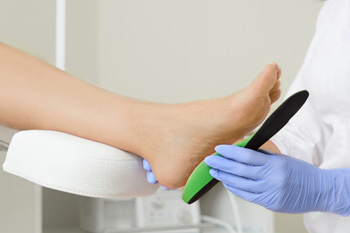 Orthotics are special shoe inserts that are designed to help correct a variety of foot related issues by relieving pressure or realigning the feet. They can also help reduce pain in the feet, knees, and lower back. There are three common types of orthotics known as soft, rigid, and semi-rigid. Soft orthotics are made to provide extra cushioning while the foot is planted on the ground. Semi-rigid orthotics, which are often used on flat feet, are designed to provide both cushioning and stability. Meanwhile, rigid orthotics are designed to provide stability and to help prevent movements that can cause pain. Patients who believe that orthotics are right for them should visit a podiatrist. A podiatrist will be able to customize an orthotic and tailor it to your needs.
Orthotics are special shoe inserts that are designed to help correct a variety of foot related issues by relieving pressure or realigning the feet. They can also help reduce pain in the feet, knees, and lower back. There are three common types of orthotics known as soft, rigid, and semi-rigid. Soft orthotics are made to provide extra cushioning while the foot is planted on the ground. Semi-rigid orthotics, which are often used on flat feet, are designed to provide both cushioning and stability. Meanwhile, rigid orthotics are designed to provide stability and to help prevent movements that can cause pain. Patients who believe that orthotics are right for them should visit a podiatrist. A podiatrist will be able to customize an orthotic and tailor it to your needs.
If you are having discomfort in your feet and would like to try orthotics, contact 1 from 1. 1 can provide the care you need to keep you pain-free and on your feet.
What Are Orthotics?
Orthotics are inserts you can place into your shoes to help with a variety of foot problems such as flat feet or foot pain. Orthotics provide relief and comfort for minor foot and heel pain but can’t correct serious biomechanical problems in your feet.
Over-the-Counter Inserts
Orthotics come in a wide variety of over-the-counter inserts that are used to treat foot pain, heel pain, and minor problems. For example, arch supports can be inserted into your shoes to help correct overarched or flat feet, while gel insoles are often used because they provide comfort and relief from foot and heel pain by alleviating pressure.
Prescription Orthotics
If over-the-counter inserts don’t work for you or if you have a more severe foot concern, it is possible to have your podiatrist prescribe custom orthotics. These high-quality inserts are designed to treat problems such as abnormal motion, plantar fasciitis, and severe forms of heel pain. They can even be used to help patients suffering from diabetes by treating foot ulcers and painful calluses and are usually molded to your feet individually, which allows them to provide full support and comfort.
If you are experiencing minor to severe foot or heel pain, it’s recommended to speak with your podiatrist about the possibilities of using orthotics. A podiatrist can determine which type of orthotic is right for you and allow you to take the first steps towards being pain-free.
If you have any questions please contact 1 located in 11111111111111111111111111111. We offer the newest diagnostic and treatment technologies for all your foot and ankle needs.
Read more about Ankle Foot Orthotics for Athletes